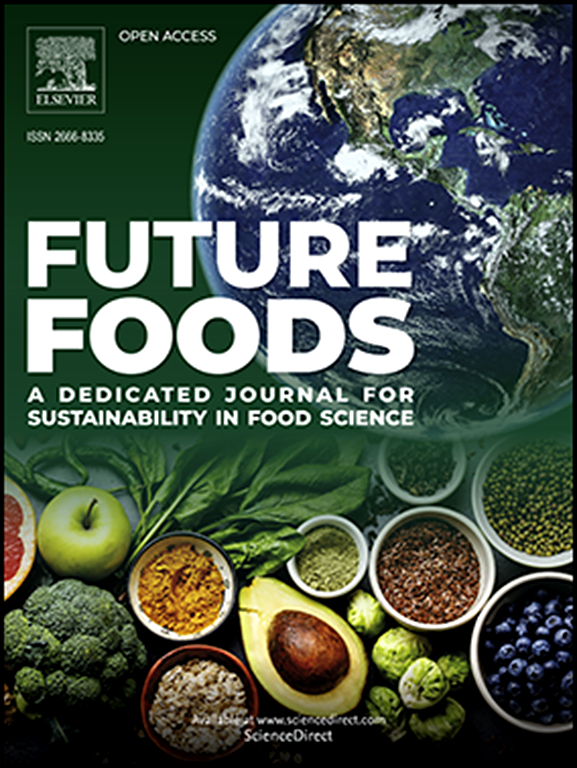香菇菌丝(霉菌蛋白)-水胶体复合材料的结构表征及流变学分析
IF 8.2
Q1 FOOD SCIENCE & TECHNOLOGY
引用次数: 0
摘要
尽管天然食品级水胶体作为稳定剂、乳化剂和质地调节剂在替代食品配方中的应用越来越多,但对它们与真菌蛋白的相互作用的了解有限。在这项研究中,我们旨在研究含有不同水胶体(植物蛋白和多糖)的真菌蛋白香菇菌丝(LEM)复合材料的流变学和结构特性。我们采用流变学测量、傅里叶变换红外光谱、扫描电子显微镜和织构分析来研究LEM复合材料的粘弹性、分子和结构特性。lem蛋白复合材料(大豆、豌豆、绿豆和大米蛋白)表现出良好的流动性和改善的分散性,表明它们在配制液体食品(如酱汁、调味品和酸奶)中的应用。lem -多糖复合材料(琼脂[Ag]、卡拉胶[Ca]和结冷胶)成功形成了凝胶型结构,提高了凝胶强度。这种稳定的LEM复合凝胶通过分子间β-片氢键与多糖相互作用。其中,LEM-Ca具有高度均匀且相互连接的凝胶网络,具有较高的凝胶黏结性。这些发现为用于食品配方(液体或固体型)的lem水胶体的开发提供了关键见解,并为优化基于真菌蛋白的食品提供了有价值的指导。本文章由计算机程序翻译,如有差异,请以英文原文为准。

Structural characterization and rheological analysis of Lentinus edodes mycelium (mycoprotein)–hydrocolloid composites for food formulation
Despite the increasing application of natural food-grade hydrocolloids as stabilisers, emulsifiers, and texture modifiers in alternative food formulations, there is limited understanding of their interaction with mycoproteins. In this study, we aimed to investigate the rheological and structural properties of the mycoprotein Lentinus edodes mycelium (LEM) composites containing different hydrocolloids (plant proteins and polysaccharides). We employed rheological measurements, Fourier transform infrared spectroscopy, scanning electron microscopy, and textural analyses to investigate the viscoelastic, molecular, and structural properties of LEM composites. LEM–protein composites (soy, pea, mung bean, and rice proteins) exhibited good flowability with improved dispersion, indicating their application in formulating liquid-based foods, such as sauces, dressings, and yoghurts. LEM–polysaccharide composites (agar [Ag], carrageenan [Ca], and gellan gum) successfully formed gel-type structures with improved gel strength. Such stable LEM composite gels interacted with polysaccharides via intermolecular β-sheet hydrogen bonds. Among the polysaccharides, LEM–Ca had highly homogeneous and interconnected gel networks accompanied by high gel cohesiveness. These findings offer key insights into the development of LEM–hydrocolloids for food formulations (liquid- or solid-type) and provide valuable guidance for optimising mycoprotein-based food products.
求助全文
通过发布文献求助,成功后即可免费获取论文全文。
去求助
来源期刊

Future Foods
Agricultural and Biological Sciences-Food Science
CiteScore
8.60
自引率
0.00%
发文量
97
审稿时长
15 weeks
期刊介绍:
Future Foods is a specialized journal that is dedicated to tackling the challenges posed by climate change and the need for sustainability in the realm of food production. The journal recognizes the imperative to transform current food manufacturing and consumption practices to meet the dietary needs of a burgeoning global population while simultaneously curbing environmental degradation.
The mission of Future Foods is to disseminate research that aligns with the goal of fostering the development of innovative technologies and alternative food sources to establish more sustainable food systems. The journal is committed to publishing high-quality, peer-reviewed articles that contribute to the advancement of sustainable food practices.
Abstracting and indexing:
Scopus
Directory of Open Access Journals (DOAJ)
Emerging Sources Citation Index (ESCI)
SCImago Journal Rank (SJR)
SNIP
 求助内容:
求助内容: 应助结果提醒方式:
应助结果提醒方式:


